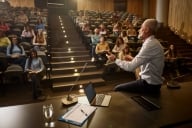You have /5 articles left.
Sign up for a free account or log in.

Courtesy of Landmark College
Landmark College, the first college in the United States for students with learning disabilities, is growing enrollment in its online courses. The rural Vermont college is designed exclusively for students who have diagnosed learning disabilities, such as dyslexia, autism spectrum disorder or ADHD.
“These are bright students, intelligent students, but often they have not succeeded in traditional classroom settings,” said Rick Bryck, dean of Landmark’s school of educational research and innovation.
The National Center for Learning Disabilities estimates that one in five children in the U.S. has learning or attention issues, although only a small portion of those are identified in schools. Only about 71 percent of students with specific learning disabilities leave high school with a regular diploma -- trailing the national rate by about 10 percentage points. Students with learning disabilities are half as likely as their peers to enroll in a four-year college and twice as likely to be jobless when they reach working age. The gap widens for African American, Hispanic and Native American students with learning disabilities -- only 65 percent of whom leave high school with a diploma.
To address these problems and hopefully enable students with learning disabilities to succeed, Landmark employs some different pedagogies and structures in both its online and on-campus classes.
Much of Landmark’s philosophy revolves around a concept called universal design for learning. The framework asks instructors to provide students with multiple options for learning material and multiple options for demonstrating their learning. Learning through video or audio might be better for some students than text, the framework suggests. Writing papers or taking an exam might not be best for everyone.
“We can best serve all of our range of students with learning differences by starting from the beginning with good design principles,” Bryck said.
Landmark also focuses on providing students with “executive function support.” Executive function refers to mental skills like short-term memory, self-control and flexible thinking, which many students with learning disabilities struggle with. Poor executive functioning might mean a student has trouble getting to class on time or starting work in advance.
In Landmark classes, executive function support means breaking learning down into “microunits,” Bryck said, and being explicit in instructions. Outside the classroom, on-campus students have access to executive function coaches who use questioning and reflection to help students achieve their goals, while online students have access to similar advisers.
Meghan Whittaker, director of policy and advocacy at the National Center for Learning Disabilities, said that the curriculum, courses and trained faculty Landmark offers are certainly helpful for students with learning disabilities. But getting those supports and services into every college should be the real goal for higher education, she said. Persistence in college can be a major problem among students with learning disabilities as they struggle to get the accommodations they need. Many faculty members at traditional colleges are subject matter experts, Whittaker said, but they are often not trained in teaching, potentially adding to problems for students with disabilities.
“What schools like Landmark offer is that students learn to self-advocate but are in an environment that is much more welcoming and inclusive of their needs,” Whittaker said. “The unfortunate part is that it's only available for students that can afford it.”
Of Landmark’s population of first-time, full-time, degree-seeking students, only about 36 percent graduate, which in this context means completing their associate degree in three years or their bachelor’s degree in six years.
But in 2018 only 33 percent of students who entered Landmark counted as first-time, full-time, meaning that they arrived straight from high school and are taking a full course load. Internal findings by the college say 83 percent of Landmark college students achieve their goals, though those goals may not include getting a degree from Landmark.
Whittaker noted that colleges exclusively for students with learning disabilities often act as a sort of bridge into traditional higher education.
While the college attracts over 450 students to campus, its online courses for students with disabilities are available only to high school or gap-year students. In many cases students can earn college and high school credit simultaneously.
Part of the goal in focusing on younger students was to help them transition into college, a move that can be more fraught for students with learning disabilities. "They’re not only earning college credit," said Tabitha Mancini, director of customer relations and outreach for online programs at Landmark, "but we’re also helping to scaffold and build the skills they need for successful transition into higher education."
Landmark officials say they try to migrate their philosophy into an online classroom. The online dual-enrollment classes keep student numbers small (12 to 14 students) and limit the amount of text students are required to read.
Online courses at Landmark are offered in a wide range of disciplines and are $1,000 per course. The majority of the 100 or so students who participate each semester are from public or private high schools that have partnered with Landmark, some of which focus on students with learning disabilities. The college also deploys “liaisons,” modeled after on-campus executive function support, to help online students succeed. A liaison might be a designated employee of one of these partner schools, or otherwise an employee of Landmark’s. Although liaisons are taught Landmark’s philosophy, approach and technology systems, they are not required to be special educators.
The Challenges of Online for Students With Disabilities
Whittaker said that generally there have been concerns around both online programs and dual enrollment for students with learning disabilities -- ones she is hopeful a place like Landmark can mitigate.
“By and large, we have not seen online programs do a good job for students with disabilities,” she said. “In online programs it’s much harder for teachers to read student cues, to know if they’re falling behind, to know if they’re struggling.”
Dual-enrollment programs for high school students at traditional colleges can sometimes result in students with learning disabilities not being accommodated.
“The student who is enrolled in a dual-education program is still a K-12 education student,” Whittaker said. “The high school the student is enrolled in is still responsible for providing that student’s [individualized education program] and accommodations and special education services.”
But the college and faculty are under different legal obligations, making the responsibility for accommodations in those cases unclear.
“We are mixing two different laws, two different obligations, and neither is really addressing this responsibility,” she said. “The Department of Ed has really not answered questions about who is responsible for what and under what circumstances.”
If students cannot find accommodation in dual-enrollment programs, they might choose not to participate, Whittaker said, setting them even further behind their peers.
“I’m glad to see that Landmark, as a school that specializes in [learning disabilities], is getting involved in the dual-enrollment program,” Whittaker said, “because I think they could be a great partner.”








